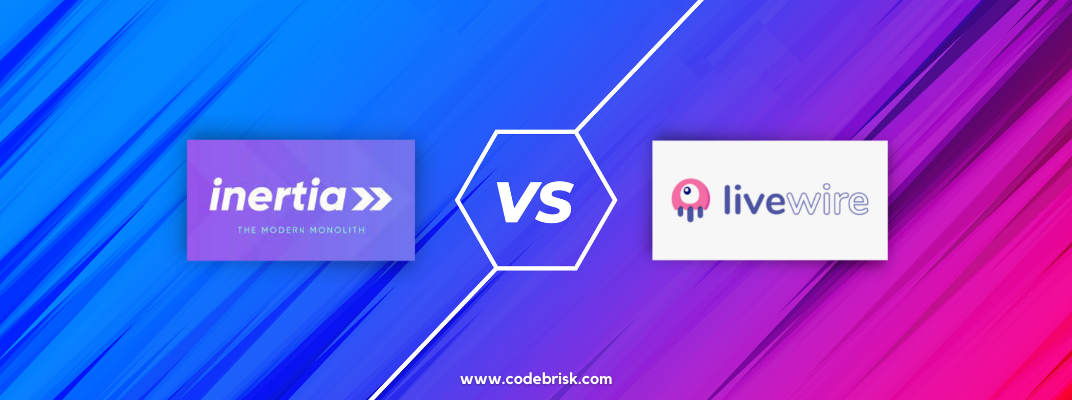Blog Detail
24
Jan
arrow_back Livewire Vs Inertia - Which one is Best for Next Web Project
Nowadays, Both Inertia.js and Livewire have been in the limelight. The two libraries often get put next to each other because of their simultaneous releases. So in this article, I’ll explain the disparities & similarities between them that might help you understand which problems they each solve best.
Laravel Livewire
Laravel Livewire is a library that makes it straightforward to build modern, reactive, dynamic interfaces using Laravel Blade as your templating language. So if you want to construct an application that is dynamic and reactive but you don’t feel comfortable jumping into a full JavaScript framework like Vue then Livewire is the best choice for you. In the first step, it renders the component outputs with the page, similar to Laravel Blade. It then executes an AJAX request to the server with updated data. The server, in turn, re-renders the components and responds with a new HTML. Finally, the framework modifies the Document Object Model (DOM) according to the changes.
In most use cases, Livewire provides the same power and dynamism as JavaScript apps. Vue is already built for reactivity, but Livewire lives on the browser, so SEO won’t be a problem if you want to be on less-advanced search engines than Google.
Inertia.js
Inertia.js was invented to integrate backend frameworks Like Laravel and Rails with modern frontend frameworks like React, Vue, and Svelte and build SPAs without the need for a backend API or a client-side router.
Inertia works much more like a classic server-side rendered app. The small library permits users to render single-file Vue components from the Laravel backend. You can create fully client-side rendered, single-page apps without the high complexity that is usually associated with modern single-page web apps (SPAs). You can create controllers, you get data from the database (via your ORM), and you render views. Except for the views here are JavaScript page components. This means you get all the power of a client-side app and the SPA experience, but you don’t need to construct an API.
In addition to Vue, Inertia also provides official support and documentation for React and Svelte. It is designed for teams that normally execute server-side applications and want to replace server-side rendered views with a JavaScript solution. In the case of Laravel, Inertia utilizes existing authentications, requires no development of the entire API, and blade views are replaced with JavaScript components.
There’s a question that which technique should be used for which project, then the answer is that, It relies on the nature of the web application and the developer’s experience with the primary technology stack. Neither Livewire nor Inertia is the ideal solution for all use cases. However, both technologies propose their users many useful features and do one thing above all, They both can save a lot of time.
Features
Laravel Livewire
- Livewire is well suited for beginners with little JavaScript experience.
- It is Beginner-friendly since AJAX requests can be made with little or no JavaScript knowledge.
- SEO-friendly, as the HTML is sent to the browser on first rendering.
- Integration into existing Laravel pages is possible.
- Automated testing is possible due to included test suite
Inertia Js
- Inertia is particularly suitable for experienced users because Vue or React knowledge is required to use Inertia.js although only Vue is currently supported by Jetstream.
- All application routes are contained in a single file.
- It eliminates the complexity of client-side routing.
- It can be set up with React.
In this article, we investigated the differences between Livewire and Vue.
In many cases, Livewire equips with the same power and dynamism as JavaScript applications. Vue is already made for reactivity, but Livewire lives on the browser, so SEO won’t be a concern if you want to be on less-advanced search engines than Google. In the end, I would say, if you like developing in Vue, React, or another frontend framework, you’ll choose Inertia. If you love Blade and want to write less JavaScript, Livewire would likely be your weapon of choice.
As we believe Vue, Inertia & Livewire are the future of web development, we have built an impeccable team of expert Laravel & Vue Js developers who can transform your ideas into reality. Codebrisk offers custom-made solutions for both small and large IT projects that are tailored to your needs. We are open to any type of agreement and are always happy to explain any complexities. So if you have a great idea, please feel free to contact us or start a project with us.
Published at : 24-01-2022
Rizwan Aslam
I am a highly results-driven professional with 12+ years of collective experience in the grounds of web application development especially in laravel, native android application development in java, and desktop application development in the dot net framework. Now managing a team of expert developers at Codebrisk.

Launch project
